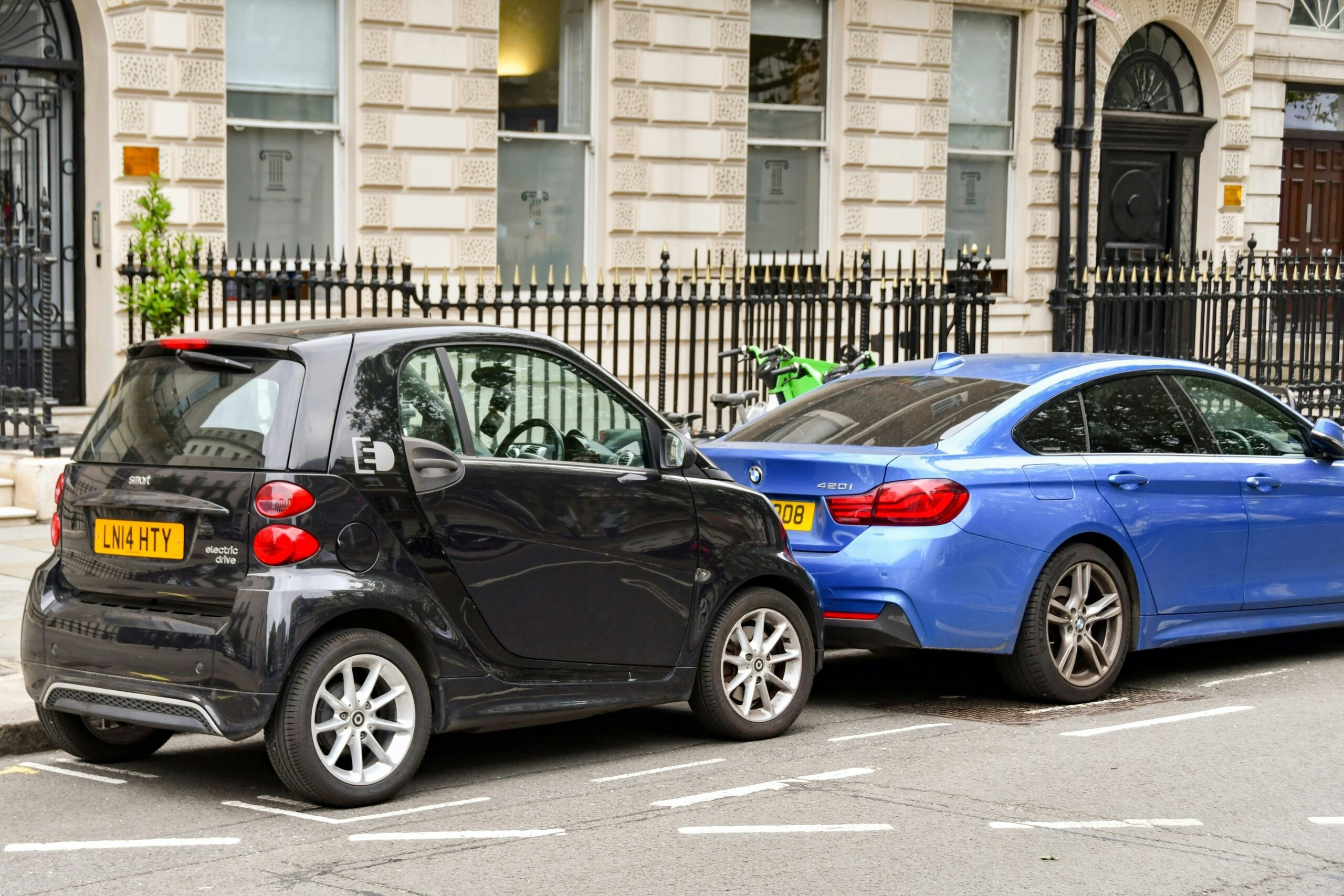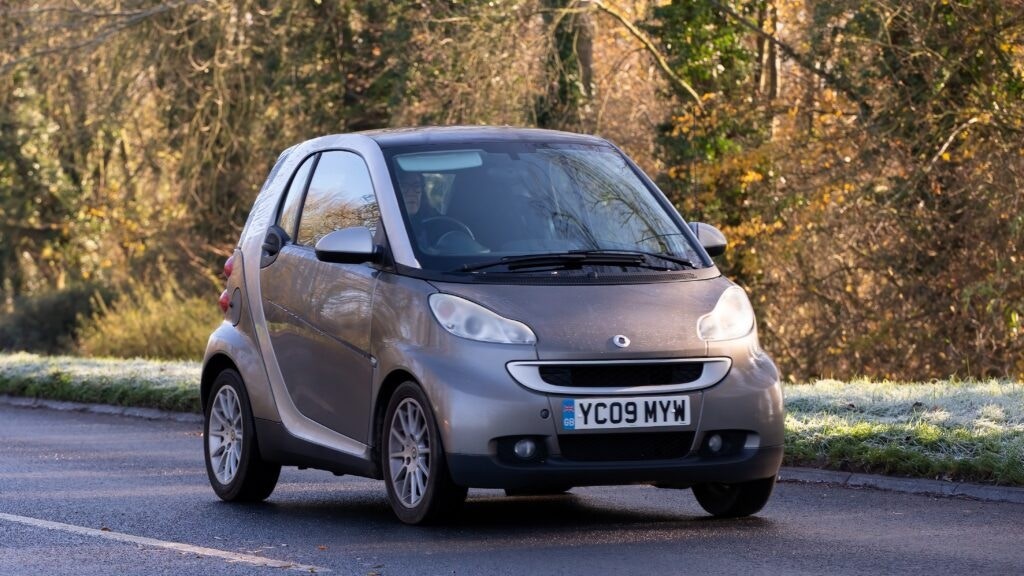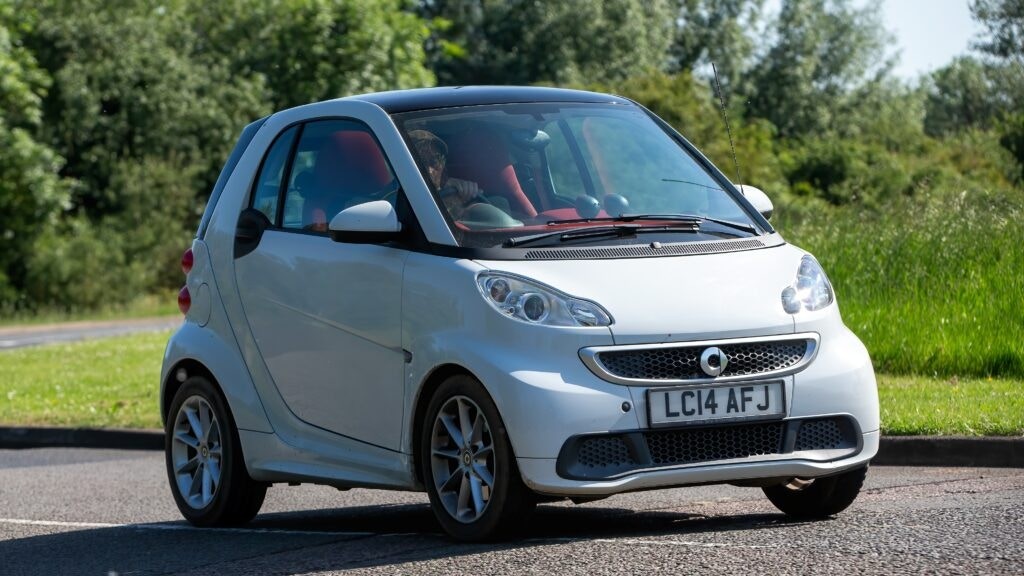Who Builds Smart Cars? Smart cars, known for their compact design and urban-friendly features, are a popular choice for city dwellers. Join CARS.EDU.VN as we delve into the history, evolution, and future of smart car manufacturing, highlighting the key players and innovations driving this unique segment of the automotive industry. Discover the manufacturers and delve into the eco-friendly and future-forward approach to smart car production, examining how these vehicles are built and where the industry is headed with CARS.EDU.VN.
1. The Origins of Smart Car Manufacturing
The journey of Smart cars began with a vision to revolutionize urban mobility. Let’s explore the foundational years and key collaborations that shaped the brand.
1.1. Swatch and Daimler-Benz Collaboration
In 1994, Swatch, the renowned Swiss watchmaker, partnered with Daimler-Benz (now Mercedes-Benz) to conceptualize a compact and eco-friendly vehicle perfect for urban environments. This collaboration brought together Swatch’s innovative design approach and Daimler-Benz’s automotive engineering expertise. The initial aim was to create a car that was not only small and efficient but also safe and easy to maneuver in crowded city streets, according to a report by Automotive News Europe.
1.2. The Birth of the Smart City-Coupé Prototype
By 1997, the partnership yielded the Smart City-Coupé prototype. This design emphasized efficiency, safety, and maneuverability, setting the stage for a revolutionary urban vehicle. The prototype featured a compact body, a fuel-efficient engine, and a unique Tridion safety cell, which became a signature element of Smart cars.
2. Key Players in Smart Car Production
Understanding who builds smart cars involves recognizing the central roles of Daimler AG and Geely.
2.1. Daimler AG’s Role
Daimler AG, the parent company of Mercedes-Benz, has been instrumental in the production of Smart cars since their inception. Daimler’s involvement ensured that Smart cars were built with high engineering standards and innovative technologies. The company provided the necessary infrastructure, resources, and expertise to bring the Smart car vision to reality.
2.2. Smart Automobile: A Subsidiary of Daimler AG
Smart Automobile was established as a subsidiary of Daimler AG to focus specifically on the design, development, and manufacturing of Smart cars. Based in Böblingen, Germany, Smart Automobile has been at the forefront of urban mobility solutions. The company’s dedication to creating small, environmentally friendly vehicles has made Smart cars a popular choice for city drivers, as highlighted in a Forbes article on urban transportation.
2.3. Geely’s Partnership with Mercedes-Benz
In 2020, Smart entered a new era through a partnership between Daimler AG and Geely Holding Group, a Chinese automotive giant. This collaboration aimed to transform Smart into a leader in electric vehicles (EVs) and expand its market reach globally. Geely’s expertise in EV technology, combined with Mercedes-Benz’s premium brand positioning, has paved the way for a new generation of Smart cars. The partnership reflects a strategic move towards sustainable and innovative urban mobility solutions.
3. The Evolution of Smart Car Manufacturing
From its early beginnings to its current focus on electric vehicles, the manufacturing of Smart cars has undergone significant changes.
3.1. 1998-2019: Expansion and Innovation
The launch of the Smart City-Coupé in 1998 marked the beginning of Smart Automobile’s journey. Renamed the Smart ForTwo, the vehicle’s compact design and innovative features quickly gained attention. Over the years, Smart expanded its lineup with models like the ForFour and introduced electric versions, enhancing its eco-friendly appeal.
3.2. Electric Vehicle Transition
Smart’s transition to electric drive represents a significant step towards eco-friendly urban transportation. Electric powertrains eliminate tailpipe emissions, contributing to cleaner city air. By leveraging advancements in battery technology, Smart cars now offer improved range and performance. This transition reduces the carbon footprint and aligns with global efforts to combat climate change, ensuring Smart remains relevant in an evolving automotive landscape, according to a report by the International Energy Agency.
3.3. Smart EQ Rebrand
The Smart EQ rebrand underscores the brand’s commitment to sustainability and electrification. EQ stands for ‘Electric Intelligence’ and reflects Smart’s dedication to innovative electric mobility solutions. The rebrand involves not only a name change but also a comprehensive shift in design, technology, and marketing. By embracing the EQ identity, Smart aims to attract environmentally conscious consumers and establish itself as a pioneer in the electric vehicle market, promoting a greener future.
3.4. Geely-Mercedes Partnership and Beyond
In 2020, the Smart brand entered a new phase by partnering with Geely, a Chinese automotive giant, and Daimler AG. This collaboration aimed to reinvent Smart, focusing on electric vehicles (EVs) and broader market reach. Under this new strategy, Smart began developing advanced electric models, leveraging Geely’s expertise in EV technology and Mercedes-Benz’s premium positioning. This partnership marks a shift towards a more global and sustainable future for the Smart brand.
4. Smart Car Models Over the Years
Smart cars have evolved significantly while maintaining their core design principles. Let’s explore the different generations and standout models.
4.1. First Generation (1998–2006)
The first generation of Smart cars introduced the iconic ForTwo model, known for its ultra-compact dimensions and innovative design.
| Model | Year Launched | Characteristics |
|---|---|---|
| ForTwo | 1998 | Compact dimensions, innovative design, tailored for the urban environment, 0.6-liter engine. |
| ForFour | 2004 | Slightly larger than the Smart ForTwo, helped establish the Smart brand, demonstrated the feasibility of small, efficient vehicles for city driving. |



4.2. Second Generation (2006–2014)
The second generation brought significant updates to the ForTwo and reintroduced the ForFour with enhanced features.
| Model | Year Launched | Characteristics |
|---|---|---|
| ForTwo (2nd gen.) | 2006 | New design, improved safety features, robust build, updated engine options. |
| ForFour (2nd gen.) | 2007 | Reintroduced with enhanced features to further cater to diverse customer needs. |
| Smart ED | 2007 | Smart Car’s first electric model, highlighted Smart’s commitment to eco-friendly driving. |
4.3. Third Generation (2014–Present)
The third generation continued to enhance the ForTwo and ForFour, with a focus on improved EV options and technology.
| Model | Year Launched | Characteristics |
|---|---|---|
| ForTwo (3rd gen.) | 2014 | New design elements, enhanced technology, improved EV options. |
| ForFour (3rd gen.) | 2014 | New design elements, enhanced technology, improved EV options. |
| Smart EQ | 2016 | Marked a shift towards full electric mobility, emphasized Smart’s sustainability and connectivity credentials. |
5. Standout Smart Car Models
Several Smart car models have made a significant impact on the automotive industry.
5.1. Smart #1 Brabus
The Smart #1 Brabus, launched as part of Smart’s collaboration with Geely, represents a performance-oriented electric vehicle. It features enhanced power and sportier design elements, showcasing Smart’s commitment to combining performance with urban efficiency. The model highlights the brand’s focus on expanding its electric vehicle lineup.
5.2. Smart ForTwo
The Smart ForTwo remains the flagship model, renowned for its compact size and agility. Since its inception, it has undergone several updates to improve safety, technology, and efficiency. The latest iterations focus on urban mobility, offering a blend of practicality and modern features.
5.3. Smart ForFour
The Smart ForFour, designed as a slightly larger alternative to the ForTwo, caters to those needing more space while maintaining a compact footprint. It offers versatility with improved interior space and functionality, appealing to families and urban drivers alike.
5.4. Upcoming Smart #3
The upcoming Smart #3 is set to expand Smart’s electric vehicle offerings further. Anticipated to feature advanced technology and a modern design, Smart #3 aims to continue the brand’s evolution towards sustainable and innovative urban mobility solutions. This model is expected to play a key role in Smart’s future growth and technological advancements.
6. The Shift to Electric Mobility
Smart’s commitment to electric vehicles is transforming its manufacturing processes and future outlook.
6.1. Transition to Electric Drive
Smart’s transition to electric drive represents a significant step towards eco-friendly urban transportation. Electric powertrains eliminate tailpipe emissions, contributing to cleaner city air. By leveraging advancements in battery technology, Smart cars now offer improved range and performance. This transition reduces the carbon footprint and aligns with global efforts to combat climate change, ensuring Smart remains relevant in an evolving automotive landscape.
6.2. Smart EQ Rebrand
The Smart EQ rebrand underscores the brand’s commitment to sustainability and electrification. EQ stands for ‘Electric Intelligence’ and reflects Smart’s dedication to innovative electric mobility solutions.
6.3. Future Plans for Smart Cars
Smart’s plans involve expanding its electric vehicle lineup and enhancing technological features. By the end of 2024, Smart aims to introduce new models with extended range and advanced connectivity options. The future focus will be autonomous driving capabilities and integrating renewable energy sources for charging. These plans signify Smart’s long-term vision of leading the urban mobility revolution, ensuring sustainability and innovation remain at the core of its strategy.
7. Manufacturing Locations and Global Presence
Smart cars are manufactured in various locations around the world, reflecting their global presence and market reach.
7.1. European Manufacturing Facilities
Initially, Smart cars were primarily manufactured at the Hambach plant in France. This facility played a crucial role in the early production and assembly of Smart vehicles. Over time, production has expanded to include other European locations to meet growing demand.
7.2. Expansion into China with Geely
With the partnership between Daimler AG and Geely, Smart has expanded its manufacturing footprint into China. Geely’s advanced manufacturing facilities in China are now producing Smart cars for the global market. This expansion leverages Geely’s expertise in EV technology and manufacturing efficiency, supporting Smart’s ambitious growth plans.
7.3. Global Distribution Network
Smart cars are sold and distributed through a global network of dealerships and distributors. The brand has a strong presence in Europe, North America, and Asia, with plans to further expand into emerging markets. This global distribution network ensures that Smart cars are accessible to customers around the world, contributing to the brand’s success.
8. Innovations in Smart Car Manufacturing
Smart car manufacturing incorporates several innovations that set it apart from traditional automotive production.
8.1. Compact Design and Engineering
One of the key innovations in Smart car manufacturing is the compact design and engineering of the vehicles. Smart cars are designed to be as small and lightweight as possible, making them ideal for urban environments. This requires innovative engineering solutions to ensure safety, performance, and comfort within a limited space.
8.2. Tridion Safety Cell
The Tridion safety cell is a distinctive feature of Smart cars, providing a high level of occupant protection. This safety cell is made of high-strength steel and is designed to absorb and distribute impact energy in the event of a collision. The Tridion cell has become a hallmark of Smart cars, demonstrating the brand’s commitment to safety.
8.3. Sustainable Materials and Production Processes
Smart is committed to using sustainable materials and production processes in its manufacturing operations. This includes using recycled materials, reducing waste, and minimizing energy consumption. By prioritizing sustainability, Smart aims to reduce its environmental impact and promote a greener future for the automotive industry.
9. Future Trends in Smart Car Manufacturing
The future of Smart car manufacturing is likely to be shaped by several key trends, including electrification, autonomous driving, and connectivity.
9.1. Enhanced Electric Vehicle Technology
As Smart continues its transition to electric mobility, advancements in battery technology and charging infrastructure will be crucial. Future Smart cars are expected to feature longer ranges, faster charging times, and improved energy efficiency. These enhancements will make Smart EVs even more attractive to urban drivers.
9.2. Autonomous Driving Capabilities
Autonomous driving technology is another key trend that is expected to shape the future of Smart car manufacturing. Smart cars may incorporate advanced driver-assistance systems (ADAS) and, eventually, full autonomous driving capabilities. This would enhance safety, convenience, and efficiency for urban commuters.
9.3. Connectivity and Smart City Integration
Connectivity is becoming increasingly important in the automotive industry, and Smart cars are no exception. Future Smart cars are expected to be highly connected, with seamless integration with smartphones, smart homes, and smart city infrastructure. This would enable a range of new services and features, such as real-time traffic updates, remote vehicle monitoring, and over-the-air software updates.
10. Caring for Your Smart Car
Owning a Smart car comes with its own set of maintenance needs. CARS.EDU.VN is here to help you keep your vehicle in top condition.
10.1. Regular Maintenance Tips
Regular maintenance is essential for keeping your Smart car running smoothly. This includes checking and changing the oil, replacing air filters, inspecting brakes, and maintaining proper tire pressure. Following the manufacturer’s recommended maintenance schedule can help prevent costly repairs and extend the life of your vehicle.
10.2. Common Issues and Solutions
Like all cars, Smart cars can experience common issues. These may include battery problems, electrical issues, and engine troubles. Knowing how to identify and address these issues can help you keep your Smart car in good working order. CARS.EDU.VN offers guides and resources to help you troubleshoot common problems and find reliable repair services.
10.3. Finding Reliable Service and Parts
Finding reliable service and parts is crucial for maintaining your Smart car. Look for certified mechanics and reputable auto parts suppliers. CARS.EDU.VN can help you locate trusted service providers in your area, ensuring that your Smart car receives the best possible care.
11. Frequently Asked Questions (FAQs)
Here are some common questions about Smart car manufacturing and ownership.
11.1. What’s the biggest problem with smart cars?
The biggest problem with Smart cars is their limited range and battery life. Despite improvements, the relatively short driving range between charges can be inconvenient for longer journeys, making them more suitable for urban commuting rather than extended travel.
11.2. How much does a Smart Car cost?
Depending on the model and features, a new Smart car typically costs between $20,000 and $30,000. Prices vary based on specifications and optional extras, making them relatively affordable in the electric vehicle market.
11.3. How fast is a Smart Car?
A Smart car’s top speed is around 81 mph (130 km/h). While not designed for high-speed performance, this speed is adequate for city driving and short motorway trips, ensuring a balance between efficiency and practicality.
11.4. Who are the primary manufacturers of Smart cars today?
The primary manufacturers of Smart cars today are Daimler AG (Mercedes-Benz) and Geely Holding Group through their joint venture.
11.5. Where are Smart cars currently manufactured?
Smart cars are currently manufactured in Europe and China, leveraging the manufacturing expertise of both Daimler AG and Geely.
11.6. What is the Tridion safety cell?
The Tridion safety cell is a distinctive feature of Smart cars, providing a high level of occupant protection. It is made of high-strength steel and designed to absorb and distribute impact energy in the event of a collision.
11.7. How is Smart transitioning to electric mobility?
Smart is transitioning to electric mobility by focusing on developing and producing electric vehicle models under the Smart EQ brand, leveraging advancements in battery technology and charging infrastructure.
11.8. What are the future plans for Smart car manufacturing?
Future plans for Smart car manufacturing include expanding the electric vehicle lineup, enhancing technological features, developing autonomous driving capabilities, and integrating renewable energy sources for charging.
11.9. What kind of maintenance is required for Smart cars?
Smart cars require regular maintenance, including oil changes, air filter replacements, brake inspections, and tire maintenance. Following the manufacturer’s recommended maintenance schedule is essential for keeping your Smart car running smoothly.
11.10. Where can I find reliable service and parts for my Smart car?
You can find reliable service and parts for your Smart car by looking for certified mechanics and reputable auto parts suppliers. CARS.EDU.VN can help you locate trusted service providers in your area.
12. Conclusion: The Future of Smart Cars
The journey of Smart car manufacturing from its inception to its current focus on electric vehicles represents a significant evolution in urban mobility. With key players like Daimler AG and Geely driving innovation and sustainability, Smart cars are poised to play an increasingly important role in the future of transportation.
CARS.EDU.VN: Your Ultimate Resource for Smart Car Information
At CARS.EDU.VN, we are dedicated to providing you with the latest information and resources about Smart cars and the automotive industry. Whether you’re looking to buy, maintain, or simply learn more about Smart cars, we have you covered.
Do you find it challenging to locate dependable auto repair services? Are you uncertain about the proper maintenance procedures to prevent serious malfunctions? Are you struggling to decide on the best car model and manufacturer that fits your requirements and budget? Are you finding it difficult to handle minor car problems by yourself? Do you want to stay updated on the newest automotive technologies and detailed car reviews?
Visit CARS.EDU.VN for detailed guides, expert reviews, and practical tips to keep you informed and confident. Contact us at 456 Auto Drive, Anytown, CA 90210, United States, or via WhatsApp at +1 555-123-4567. Let cars.edu.vn be your trusted resource for all things automotive.
